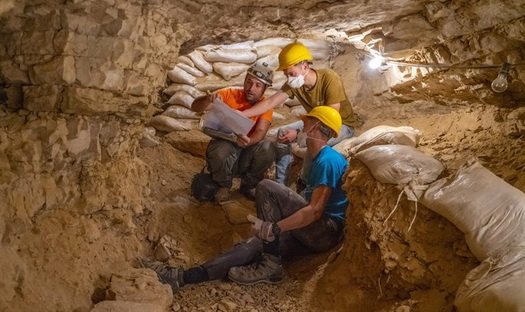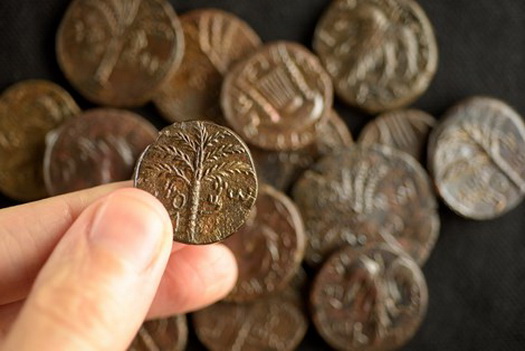
Bible Scroll from Bar Kochba Era Discovered in Judean Desert
“These are the things you are to do: Speak the truth to one another, render true and perfect justice in your gates. And do not contrive evil against one another, and do not love perjury, because all those are things that I hate—declares the Lord.”
These verses, from Zechariah 8:16–17, were discovered in a cave where Jewish refugees hid almost 1900 years ago. The verses, written on dozens of parchment fragments were discovered in a complex and challenging national-archaeological operation undertaken by the Israel Antiquities Authority on the cliffs of the Judean Desert, since 2017, in order to prevent antiquities looting.
The historic discovery comes 60 years after the last discovery of biblical scrolls in archaeological excavations. In addition to the scroll fragments, the operation uncovered additional extraordinary finds from various periods: a cache of rare coins from the days of Bar-Kokhba, a 6,000 year-old skeleton of a child – likely female, wrapped in a cloth and mummified, and a large complete basket dating back 10,500 years, likely the oldest in the world.
The national project of surveying the caves of the Judean Desert and their excavation is undertaken in desert caves and ravines since 2017, by the Israel Antiquities Authority, in cooperation with Staff Officer of the Archaeology Department of the Civil Administration in Judea and Samaria, and funded by the Ministry of Jerusalem Affairs and Heritage. Today, its results were first unveiled.
The Dead Sea Scrolls include the earliest known copies of the Biblical Books. As such, they are considered the most important archaeological discovery of the 20th century.
The scroll fragments, which bear verses from the books of the prophets Zechariah and Nahum and are written in Greek, were retrieved from the Cave of Horror in the Judean Desert reserve’s Nahal Hever by clinging to ropes between heaven and earth. The cave, roughly 80 meters below the cliff top, is flanked by gorges and can only be reached by rappelling precariously down the sheer cliff.
Additional finds left behind by the Jewish rebels who fled to the caves at the end of the Bar Kokhba Revolt include a cache of coins from the Revolt bearing Jewish symbols such as a harp and a date palm, arrow- and spear-heads, woven fabric, sandals and even lice combs.
Ever since the Dead Sea Scrolls were discovered over 70 years ago, the desert caves have been targeted by antiquities looters; the climatic conditions inside them have enabled the exceptional preservation of scrolls and ancient documents, which are cultural heritage assets of immense importance. As such, they are sought after by cave looters, who risk life and limb in their search, as well as damaging the caves and destroying historical evidence.
Since the operation began in October 2017, three teams led by Oriah Amichai, Hagay Hamer and Haim Cohen have been systematically surveying the caves in the desert cliffs.
The survey is being conducted under the administrative auspices of the Israel Antiquities Authority’s Southern Region, headed by Pablo Betzer. According to Head of the Antiquities Authority Surveys Department Dr. Ofer Sion, the head of the theft-prevention unit Amir Ganor, and the deputy head of the theft-prevention unit Dr. Eitan Klein, to date, 80 km of desert caves have been surveyed.
The complex operation included employing drones and reaching virtually inaccessible caves with the aid of rappelling techniques and mountain-climbing equipment. In addition, archaeological excavations were conducted in select caves. The meticulous survey, which included zoological and botanical aspects, is expected to shed light on the study of the Judean Desert caves.
Dozens of youths and members of pre-military preparatory programs joined the archaeological excavations in those areas that are relatively accessible. This is part of the Israel Antiquities Authority’s educational program policy, which seeks to nurture a young generation in the country that is connected to its heritage.
The fragments of the Greek scroll of the Book of the Twelve Minor Prophets discovered in the operation was written, uniquely, by two different scribes.
The conservation and study of the fragments, conducted by Tanya Bitler, Dr. Oren Ableman and Beatriz Riestra of the Dead Sea Scrolls Unit at the Israel Antiquities Authority, has allowed for the reconstruction of 11 lines of text, partially preserving the Greek translation of Zechariah 8:16–17.
Also identified, on another fragment, are verses from Nahum 1:5–6, “The mountains quake because of Him, And the hills melt. The earth heaves before Him, The world and all that dwell therein. Who can stand before His wrath? Who can resist His fury? His anger pours out like fire, and rocks are shattered because of Him.”
When comparing the text preserved in the newly discovered fragments to the text known to us from other versions of the text, including the verses known in the Masoretic text, numerous differences are notable, some of which were quite surprising. These differences can tell us quite a bit regarding the transmission of the biblical text up until the days of the Bar-Kokhba Revolt, documenting the changes that occurred over time until reaching us in the current version. Another exciting aspect about this scroll is that despite most of the text being in Greek, the name of God appears in ancient Hebrew script, known from the times of the First Temple in Jerusalem.
Another astounding discovery was found near the rock wall inside the Cave of Horror: A 6,000-year-old partially mummified skeleton of a child, wrapped in cloth.
According to prehistorian Ronit Lupu of the Israel Antiquities Authority, “On moving two flat stones, we discovered a shallow pit intentionally dug beneath them, containing a skeleton of a child placed in a fetal position. It was covered with a cloth around its head and chest, like a small blanket, with its feet protruding from it. It was obvious that whoever buried the child had wrapped him up and pushed the edges of the cloth beneath him, just as a parent covers his child in a blanket. A small bundle of cloth was clutched in the child’s hands. The child’s skeleton and the cloth wrapping were remarkably well preserved and because of the climatic conditions in the cave, a process of natural mummification had taken place; the skin, tendons, and even the hair were partially preserved, despite the passage of time”.
A preliminary study of a CT scan of the child, carried out by Dr. Hila May from Tel Aviv University, suggests that this child was 6-12 years old.
Another find, currently unparalleled worldwide, was discovered by youths from the Nofei Prat pre-military leadership academy in one of the Muraba‘at Caves in the Nahal Darga Reserve: a huge intact basket with a lid that was also exceptionally well preserved due to the high temperatures and extreme aridity of the region.
The basket dates to the Pre-Pottery Neolithic period, approximately 10,500 years ago. As far as we know, this is the oldest basket in the world that has been found completely intact and its importance is therefore immense. The basket had a capacity of 90–100 liters and was apparently used for storage. The basket provides fascinating new data on the storage of products some 1,000 years before the invention of pottery.
The basket is woven from plant material and its method of weaving is unusual. When it was found it was empty, and only future research of a small amount of soil remaining inside it will help us discover what it was used for and what was placed in it.
The study of the skeleton is currently being spearheaded by Ronit Lupu of the Israel Antiquities Authority and Dr. Hila May from the Tel Aviv University School of Medicine. The research of the earliest-known basket is being spearheaded by Dr. Naama Sukenik and Dr. Ianir Milevski of the Israel Antiquities Authority. The skeleton and basket were dated using C14, by Prof. Elisabetta Boaretto of the Scientific Archaeology Unit of the Weizmann Institute of Science.
Photos from Israel’s Antiquities Authority














